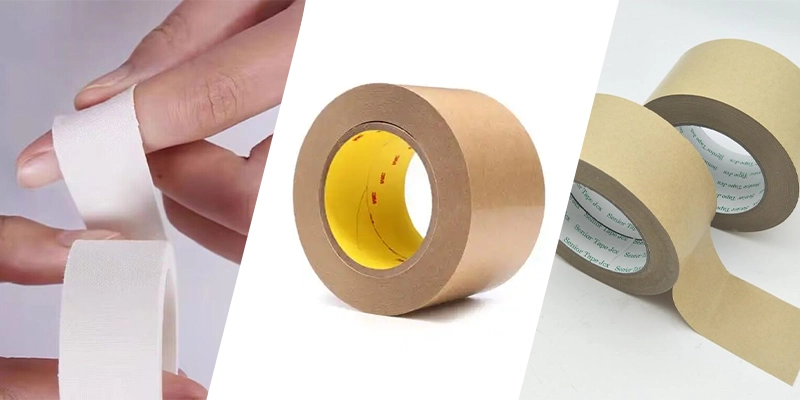Tape is made by treating both sides of paper, plastic, cloth or composite materials with anti-adhesive treatment and viscosity-enhancing treatment, and then applying adhesive on the viscosity-enhancing side. After drying, it is rolled into a coil to form a tape. Tape is widely used in the packaging industry, such as sealing and bundling of corrugated cardboard boxes and paper boxes, and bundling and tying. The reverse side of trademarks, labels, nameplates, etc. is coated with glue, which is essentially a kind of fixed tape.
The production of tape is developing rapidly in all countries in the world, and the output is also large, most of which is used for packaging.
I. Classification of Tape
Classification by the use of tape
1. Pressure-sensitive tape. Pressure-sensitive tape is also called self-adhesive tape. It is currently the most widely used and convenient tape in packaging. Pressure-sensitive tape is a tape coated with pressure-sensitive adhesive. When using it, just touch it lightly with your hands or machinery to make it adhere to the surface of the object to be adhered and achieve a certain bonding strength.
2. Heat-sensitive tape. Also known as heat-activated tape. It is a tape coated with hot-melt adhesive. When used, it needs to be heated to melt the adhesive to produce an adhesive effect.
3. Rewet tape. Also known as water-activated tape, it is a tape coated with a layer of water-activated adhesive. When used, first moisten the adhesive surface of the tape with water and then press it together.
4. Transfer tape. A layer of pressure-sensitive adhesive is applied to a non-stick substrate to make a transfer tape. When used, stick this tape on the surface of the object to be adhered, then peel off the substrate, leaving a uniform layer of pressure-sensitive adhesive on the surface of the object to be adhered, just like applying a uniform layer of adhesive, so that the tape plays the role of uniformly transferring the adhesive.
5. Label tape. This is a special label tape. One side of the substrate is printed with text or patterns to make a trademark or nameplate label, and the other side is coated with glue and the adhesive surface is sealed with release paper. When used, peel off the release paper and stick it on the product or packaging container.

2. Classification by the base material of the tape
1. Paper tape: tape with kraft paper, coated paper and other paper as the base material. The production process is simple, the production cost is low, the bonding strength is good, but the tensile strength, tear strength and waterproofness are poor. It is mainly used for sealing and bundling packaging containers such as corrugated cardboard boxes, paper boxes, and paper bags.
2. Cloth tape: tape with cotton cloth, synthetic fiber cloth, etc. as the base material. Cloth tape has good tensile strength, tear strength and water resistance. It can generally be used for sealing and bundling heavy corrugated cardboard boxes.
3. Plastic tape: tape with PVC, PE, PP, PET and other plastic films as the base material. This type of tape has high tensile strength, good water and chemical resistance, and strong adhesion. It is mostly used for sealing and bundling cartons and various types of packaging containers.
4. Metal foil-based tape: tape with aluminum foil, copper foil and lead foil as the base material. Mainly used to make labels, trademarks, nameplates, etc.
5. Tape with composite materials as the base material. Usually, the tape is based on composite materials such as paper/metal foil (aluminum foil or copper foil), paper/plastic, paper/aluminum foil/plastic, etc.

3. The structure of the tape The tape is basically composed of five parts.
1. Substrate The substrate is the carrier of the adhesive and the skeleton of the tape. The substrate is divided into transparent and opaque types. There are many types of materials to choose from, mainly paper, plastic, metal foil, cloth, composite materials, etc. As a substrate, it should have good mechanical strength, small elasticity, uniform thickness, and good wettability of the adhesive.
2. Adhesive The adhesive is the core component of the tape. Tapes of different properties are made of different types of adhesives. Common adhesives include pressure-sensitive, heat-sensitive, water-activated, etc.
3. The bottom treatment agent is also called the primer, which is applied to the surface of the substrate to increase the bonding force between the adhesive and the substrate to prevent the tape from debonding when used. Some adhesives already have sufficient adhesion to the substrate, so there is no need to apply primer.
4. Back layer treatment agent and isolation material Back layer treatment agent and isolation material are used to prevent the tape from sticking to each other when winding, making it easier to unwind. Back layer treatment agent is applied on the back of the substrate and can increase the strength of the substrate. Some back layer treatment agents can also give the substrate some special properties, such as waterproof and solvent resistance. When back layer treatment agent cannot be used, isolation material is used to prevent the tapes from sticking to each other, such as double-sided tape.


